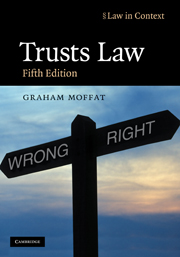Book contents
- Frontmatter
- Contents
- Preface to the fifth edition
- Acknowledgments
- Table of abbreviations
- Useful websites
- Table of statutes
- Table of statutory instruments
- Table of cases
- 1 Trusts introduced
- 2 The evolution of the private express trust
- 3 Taxation, wealth-holding and the private trust
- 4 Creating the trust – I
- 5 Creating the trust – II
- 6 Trusts and public policy
- 7 Flexibility in relation to beneficial entitlement
- 8 The taxation of private trusts
- 9 An introduction to trustees and trusteeship
- 10 Aspects of the management of trusts
- 11 Trusteeship, control and breach of trust
- 12 Implied trusts and the family home
- 13 Trusts in commerce I: occupational pension schemes
- 14 Trusts in commerce II: commerce and equitable remedies
- 15 Trusts in commerce III: commerce, credit and the trust
- 16 Trusts in commerce IV: fiduciary relationships, commerce and the trust
- 17 Trust, contract and unincorporated associations
- 18 An introduction to the law of charity
- 19 A legal definition of ‘charity’
- 20 The regulation of charities
- Index
7 - Flexibility in relation to beneficial entitlement
- Frontmatter
- Contents
- Preface to the fifth edition
- Acknowledgments
- Table of abbreviations
- Useful websites
- Table of statutes
- Table of statutory instruments
- Table of cases
- 1 Trusts introduced
- 2 The evolution of the private express trust
- 3 Taxation, wealth-holding and the private trust
- 4 Creating the trust – I
- 5 Creating the trust – II
- 6 Trusts and public policy
- 7 Flexibility in relation to beneficial entitlement
- 8 The taxation of private trusts
- 9 An introduction to trustees and trusteeship
- 10 Aspects of the management of trusts
- 11 Trusteeship, control and breach of trust
- 12 Implied trusts and the family home
- 13 Trusts in commerce I: occupational pension schemes
- 14 Trusts in commerce II: commerce and equitable remedies
- 15 Trusts in commerce III: commerce, credit and the trust
- 16 Trusts in commerce IV: fiduciary relationships, commerce and the trust
- 17 Trust, contract and unincorporated associations
- 18 An introduction to the law of charity
- 19 A legal definition of ‘charity’
- 20 The regulation of charities
- Index
Summary
Introduction
In the previous chapter we saw how the rule against perpetuities formally limits the time over which a settlor's freedom of disposition can be exercised. But it is implicit that, within that time and subject to the other public policy restraints mentioned in Chapter 6, a settlor is substantially free to dictate in the trust instrument both beneficial entitlement and the mode of trust administration. Plainly there would be little point in this freedom if the settlor's instructions could be ignored or altered at the whim of beneficiaries or trustees. Consequently, a fundamental principle of the law of trusts is that of fidelity to the settlor's intentions: trustees must faithfully implement that intention as identified through the trust instrument. The settlor is the law-maker, the trustees are the administrators of that law who must not deviate from the terms of the trust. In principle, therefore, the courts will not readily approve any deviation: ‘As a rule, the court has no jurisdiction to give, and will not give, its sanction to the performance by trustees of acts with reference to the trust estate which are not, on the face of the instrument creating the trust, authorised by its terms’ (Re New [1901] 2 Ch 534 at 544 per Romer LJ).
But neither settlors nor their advisers are imbued with the wisdom of Solomon, and they may fail to provide for unexpected developments such as unanticipated changes in investment patterns.
- Type
- Chapter
- Information
- Trusts LawText and Materials, pp. 323 - 370Publisher: Cambridge University PressPrint publication year: 2009



